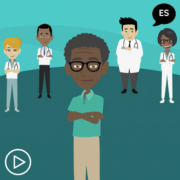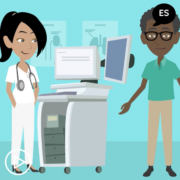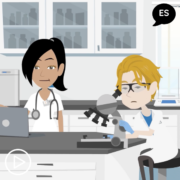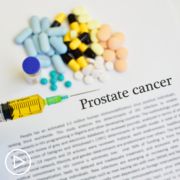Usted Tiene un Papel en Sus Decisiones de Atención del Cáncer de Próstata
Usted Tiene un Papel en Sus Decisiones de Atención del Cáncer de Próstata from Patient Empowerment Network on Vimeo.
¿Qué papel desempeñan los pacientes en las decisiones sobre el tratamiento del cáncer de próstata? Este video animado repasa el proceso de toma de decisiones compartida y describe los pasos para que los pacientes participen en su atención.
See More From Shared Decision Making: Navigating Prostate Cancer Care
Related Resources:
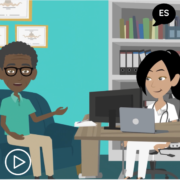
¿Qué Preguntas Debe Considerar Hacerle a Su Equipo de Atención del Cáncer de Próstata? |
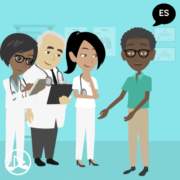
|
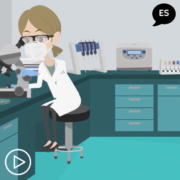
|
Transcript:
Niki:
Hola, soy Niki y soy enfermera practicante de cáncer de próstata. Y este es Anthony, que vive con cáncer de próstata avanzado.
Anthony:
¡Gracias por acompañarnos! En este video, nosotros explicaremos por qué usted debe tomar un papel activo en su atención del cáncer de próstata y revisaremos los pasos para ayudarlo a participar en las decisiones que deben tomarse.
Niki:
Así es, Anthony.
Lo que me lleva al término “toma de decisiones compartida“. Es posible que usted ya haya escuchado hablar de este término – básicamente, significa que usted y su equipo de atención médica colaboran en las decisiones de atención y el objetivo es que USTED esté en el centro de estas decisiones.
Anthony:
¡Así es! Por ejemplo, cuando llegó el momento de discutir mi plan de atención, mi médico me guio a través de las consideraciones de cada enfoque y cómo cada opción podría afectar mi estilo de vida. Yo hice preguntas y compartí mis objetivos en las conversaciones. Y me sentí ESCUCHADO.
Niki:
Exactamente – eso es una toma de decisiones compartida en acción. Cuando usted está viviendo con cáncer, a menudo los riesgos y beneficios deben ser calculados para decidir qué curso de acción podría ser mejor para su enfermedad individual. Entonces, ¿por qué es tan vital ser un participante activo? Los estudios muestran que los pacientes que participan en su atención pueden tener mejores resultados y experiencias1. Y le ayudará a aprender más sobre su enfermedad y avanzar con confianza.
Anthony:
Ahora que sabe qué ES la toma de decisiones compartida y por qué debería convertirse en un socio en su atención, repasemos los pasos que lo ayudarán a participar más:
El primer paso, y el más importante, es educarse sobre su enfermedad.
Niki:
El consultorio de su médico puede ser una gran fuente de información y recursos, por lo que es un buen lugar para comenzar. Y también hay varios grupos de defensa que proporcionan materiales educativos, por ejemplo:
- Red de Empoderamiento del Paciente, el creador de este video.
- La Fundación Contra el Cáncer de Próstata.
- El Instituto de Investigación del Cáncer de Próstata.
- La Red de Educación para la Salud de la Próstata, que se centra en los servicios y el apoyo para los hombres afroamericanos.
- Y CERO-El fin del Cáncer de Próstata.
Anthony:
Cuando usted aprenda más sobre su cáncer de próstata a través de recursos como estos, se sentirá más capacitado para expresar sus opiniones. Recuerde, es importante hablar y hacer preguntas en cada etapa.
Niki:
Entonces, ¿qué más puede hacer para ser un socio en sus decisiones?
- Primero, asegúrese de comprender y comunicar los objetivos de su atención antes de tomar cualquier decisión.
- Luego, asegúrese de estar informado sobre sus opciones y solicite materiales de apoyo si usted necesita claridad.
- Y pregunte cómo su estilo de vida puede verse afectado por cada enfoque.
- Usted también debe discutir los riesgos y beneficios de cada opción.
- Solicite recursos para ayudar en la toma de decisiones e información que pueda ayudar a determinar la mejor ruta para su enfermedad individual.
- Como siempre, traiga a un amigo o familiar y discuta sus opciones con sus seres queridos.
- Finalmente, recuerde que USTED está en el centro de su atención. Usted debe sentirse cómodo con cualquier elección antes de seguir adelante.
Anthony:
Ahora que ha visto este video, asegúrese de descargar la guía que contiene los aspectos más destacados de esta discusión – y puede imprimirla o guardarla en su computadora para consultarla en el futuro.
Niki:
Visite powerfulpatients.org/PC para acceder a más videos con Anthony y yo. ¡Gracias por acompañarnos!

